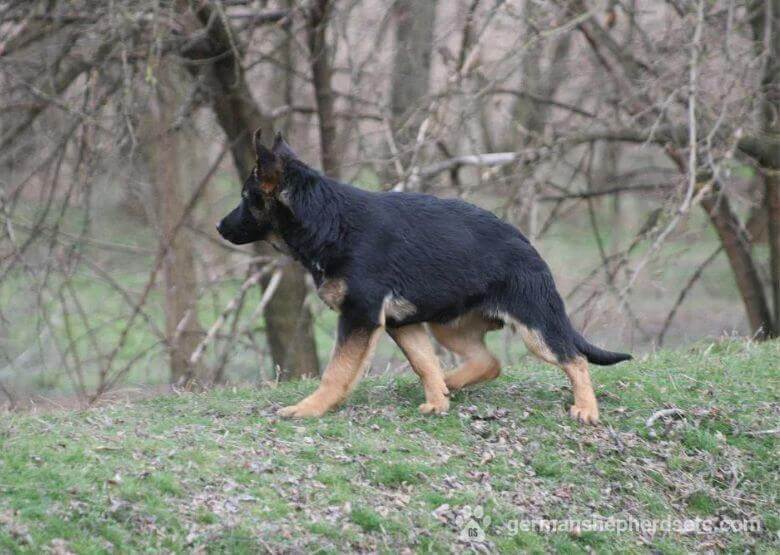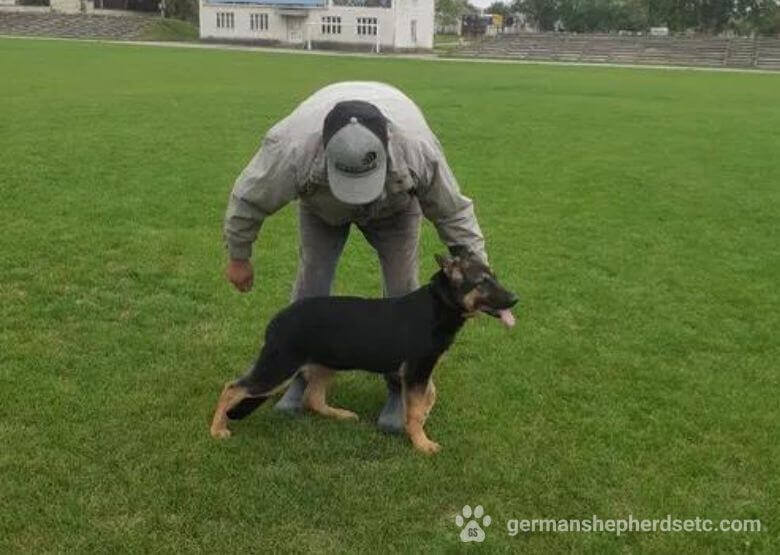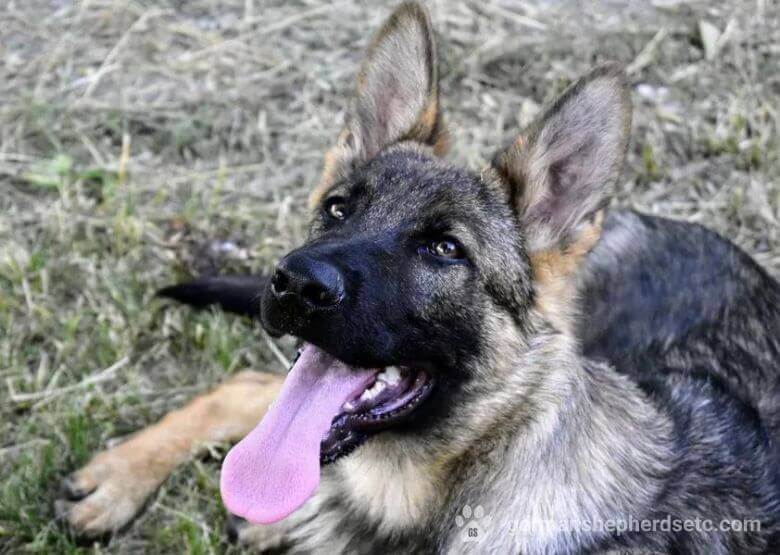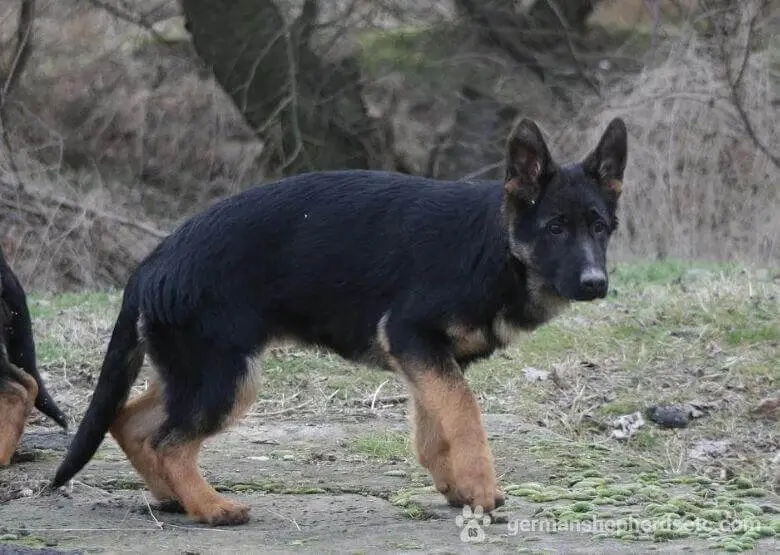Table of Contents
So, your 5 month old German Shepherd puppy does not look like a cute round and fluffy cub. It is the time when it has entered its juvenile growth stage, and it will become an adolescent in a month. Its behavior has also changed a bit. The pup is not that unruly delinquent it used to be a month ago. It becomes more obedient and shows its intelligence in training and exercising. However, it can still get into trouble, if left uncontrolled, with its immense energy making it bite, chew everything it sees, and jump at everybody it encounters. So, it may be a severe test for your patience before your pet enters the next stage of its life.
Here is what you need to know about the main characteristics of your five month old German Shepherd, its temper, behavior, energy, and training needs.
Size and Appearance
If you are worried about whether your puppy is healthy enough and has reached the normal size and height for this age, check the appropriate measurements. Measuring and weighing your doggy regularly is a good option to ensure everything is OK with it.
Your GS dog continues to gain weight quickly. The male puppy weighs about 40-49 pounds (18-22 kg), while females are a bit of lighter – 35-40 pounds (15-18 kg).
If we speak about height, boys are taller at the shoulder – 14-16 inches (35-40 cm), while girls reach 12-14 inches (30-35 cm).
Don’t worry if your puppy’s size does not fully correspond to these measurements. Check how big its parents are. If they are smaller than average, your pet may take after them. However, if the difference between the average indicators and your puppy’s height and weight is rather big, you may need to see a vet. They will recommend a specific diet to improve the situation and check whether this difference is not connected with a developmental disorder. Remember that if your puppy grows too fast, but its parents are not too big, it may also be a problem. Quick growth can cause damage to its bones.
Your 5 month old German Shepherd experiences some other developmental stages in its teeth, ears, and fur. The teething period continues. You will see that for the next two or three months. The adult teeth replace the milk ones, so the doggy needs more calcium and other nutrients in its diet. The incisors have already grown in most puppies at this time. Now, you can expect premolars and canines. So, your puppy continues to bite and chew everything it can reach. You need chewing toys at this period badly.
As for the ears, they usually stand straight up at this age. If they don’t, it can be an effect of teething, when more calcium is needed, or unwanted trauma. Anyway, you need to consult your veterinarian at this point. Droopy ears can be normal, too, so you should not interfere with the natural way in most cases. You may also need to add some supplements to the diet or change it completely to more raw meat and other natural ingredients.
Using chewing toys is helpful not only for teething. As an element of playing, they provide more exercise to the puppy’s head, jaws, and neck muscles which are responsible for perky ears. You may damage the auracles, so be careful not to play too hard with your pet, and never pat it on the head during this period.
You need to provide more attention to your puppy’s fur, too. Its adult double coat has already almost formed. So, your puppy can shed a lot and need more brushing and grooming. Talk to your vet about the ways to take proper care of the doggy’s coat.
There is one more important thing to consider about your pet’s physical development. At this age, most GS puppies start their sexual maturing. Some boys can reach it up to 6 months of age. It means they will start looking for mates. The same can be observed in girls, so don’t let your puppy walk outside and contact closely with street dogs.
5 Month Old German Shepherd Behavior and Activity

Your 5 month old GSD sleeps less and walks more at this age. It is full of energy and always ready to play a lot. Its playful nature can often get it into some trouble, so you need to watch out when your doggy is playing and running outside.
Your pet will also try to test its boundaries right now, so you need to be very consistent with your pup at this juvenile stage – it should see an indisputable leader of the pack in you and all your actions towards it. Remain pretty firm with your commands, but never forget about treats.
Your doggy needs a lot of outlets to release its energy, so if it doesn’t have a chance to do this, it can even become aggressive. Such outbursts of energy are known as ‘zoomies’. The young dog will chew and bite all the things around, destroying your shoes, socks, dresses, trousers, pieces of furniture, and other, even the most unexpected, household items. Tug-o-war and other energetic puppy games can help a lot. Work at teaching your pet not to bite. Bite inhibition should be provided regularly, strictly, and consistently.
As for walking, your doggy needs a lot of it outside. It can walk up to 10 kilometers (about 6 miles). However, never make your pet walk or run as far as that. Two walking sessions of 30-45 minutes each per day is enough.
Moreover, at this age, puppies can experience a strange adolescence problem – panosteitis. This health disorder is bone inflammation, so your pet starts limping when it gets up after a nap. If you do too much exercise with it, the results may be lameness, pain, or anorexia. This condition relieves by itself in most puppies in several days, while in others it may last for a few weeks. You may even need the vet’s help and steroid prescription. Anyway, you need to reduce running, walking, and exercising during this period and take more care of the puppy’s food and nutritious supplements.
Health and Care
Your 5 month old German Shepherd puppy is a healthy young adolescent, growing fast and feeling full of energy. By this age, it should have undergone 3 vaccination rounds, with the last vaccination session at 16-18 weeks of age for DHPP and rabies. The next rounds will be needed at the age of 12 and 16 months.
However, you should check with your veterinarian if all the due vaccines have been taken and administer them if something was skipped.
If your puppy gets good nutrition and a lot of exercises, it will grow fast and healthy. Though, you may need to know if there may be certain health issues in the future. Do thorough research on the hereditary history if you want to be preventative. Running a DNA test can also help a lot, especially if you are worried about the possible appearance of degenerative myelopathy.
You also need to be aware of some symptoms and conditions that may signal potential health issues and need the veterinarian’s consultation. So, look carefully for such things as:
- dry and itchy skin;
- urination difficulty;
- changes in personality;
- red and swollen gums;
- runny nose or eyes;
- sleeping pattern changes;
- unexplainable weight loss;
- getting too thirsty;
- frequent urination;
- vomiting;
- diarrhea;
- coughing and sneezing;
- loss of appetite.
Anyway, you need to go to the vet if you have noticed some of these signs. Moreover, you have to reconsider the care patterns. Think about more appropriate:
- exercising;
- feeding high-quality kibble or raw diet;
- checking size measurements;
- providing a convenient place to sleep;
- ensuring continuous water supply;
- ensuring timely vaccinations and anti-parasite care;
- training obedience;
- watching sexual maturity patterns and preventing contact with stray dogs;
- careful brushing and grooming;
- regular veterinary consultations.
Feeding
The 5 month old German Shepherd weight depends on proper nutrition. You can opt for either high-quality branded puppy kibble or a healthy natural diet with raw meat, fruits, and vegetables. Do not feed your little one with cheap and toxic foods, and avoid giving it too many treats.
Young German Shepherds are prone to obesity at this age, and it can lead to hip dysplasia and other health disorders, including diabetes, arthritis, hypertension, and even cancer.
If you feed your puppy with kibble, give it two cups three times per day. Try to be consistent with your feeding schedule. Never give your doggy food too close to going to bed. If the puppy does not eat all the food from its bowl, take the bowl away.
Check whether it always has enough fresh water to drink. The water bowl should be left with the dog for the whole day, so you do not need to take it away.
How to Train a 5 Month Old German Shepherd

Your 5 month old GSD is already very smart and susceptible to training. The first things to train in it are obedience and biting inhibition. You need to start doing it as soon as possible to avoid problems with its temperament and behavior in the future.
Try to be persistent, patient, and positive. You should be a leader for your dog. Though, avoid shouting and screaming or beating and forcing it to do things. That will lead to nothing better than fear and aggression.
Establish friendly communication with your pet. Let it show you what it means and what the issues are. Reinforce your doggy positively when you are training it to enhance trust and set closer bonds.
Teach your GS basic obedience that involves a set of commands to follow. They involve:
- ‘Down’ – when your doggy sits, urge it to lie down, and use a leash to direct its head and body to the ground;
- ‘Come’ – start with ‘stay’ and then begin to walk and encourage the dog to follow you;
- ‘Stay’ – start walking around the puppy but don’t let it follow you and stop it with the leash when it attempts to move;
- ‘Sit’ – sit down and show the puppy that it needs to do the same by pushing its butt to the ground;
- ‘Heel’ – stop for a while and stand still, simultaneously pulling the leash closer to your legs.
Repeat the commands frequently and give your doggy a treat every time it follows the commands successfully.
If you do not know how to train your puppy or where to start, you may need help or consultation from a professional dog trainer.
FAQ
How big is a 5 month old German Shepherd?
A young German Shepherd puppy at this age is about half of the adult dog’s size. Males are 14-16 inches (35.5-40.5 cm) at the shoulder, while females are smaller. They can reach 12-14 inches (30.5-35.5 cm).
How much should a 5 month old German Shepherd weight?
A GS puppy continues to gain weight at this age. It is up to 40-49 pounds (18-22 kg) for males and 35-40 pounds (15.5-18 kg) for females.
How much should a 5 month old German Shepherd eat?
Your pup should receive balanced nutrition of high-quality kibble – two cups, three times per day. Or you may opt for feeding natural food to it – meat, fruits, and vegetables in well-balanced proportions.
How often should I feed my 5 month old German Shepherd?
The best schedule for your GS pup at this age is three times per day. You do not need to feed it more often. Though, it is too early to transfer it to 2-time feeding. Too much food at a time may lead to overeating and cause serious digestive issues.
Final Thoughts

Your 5 month old GSD is a great source of delight and admiration. It is very playful and energetic. However, be prepared for administering more responsibility and control over its behavior. Make a thorough plan for its feeding, care, and obedience training.
German Shepherds are wonderfully intelligent dogs that need appropriate activities, training, and accurate health control schedules to become even more perfect.
